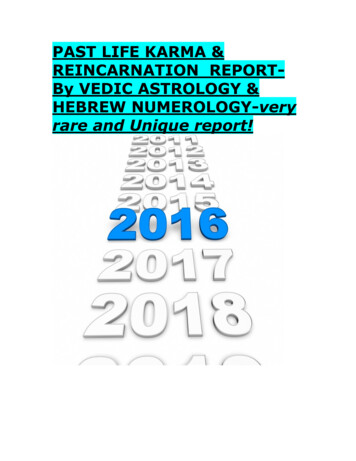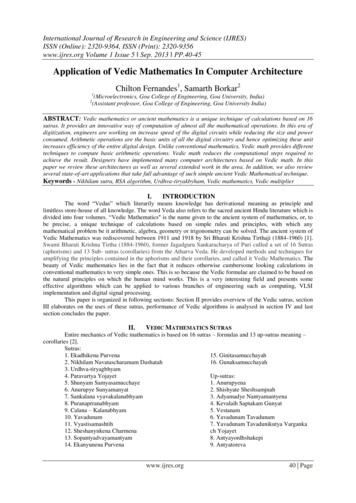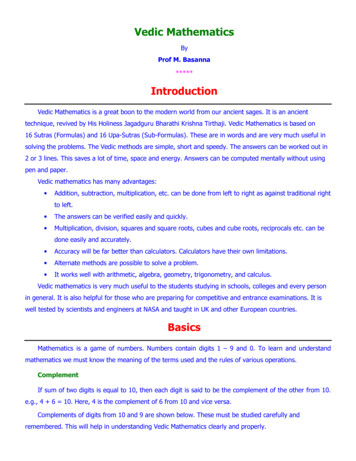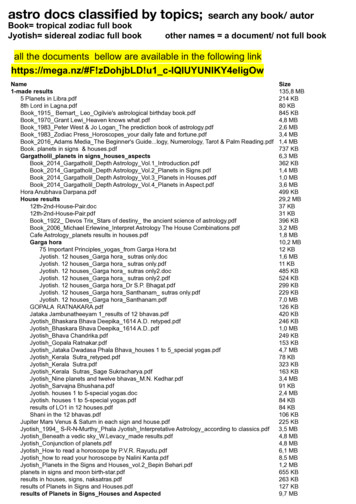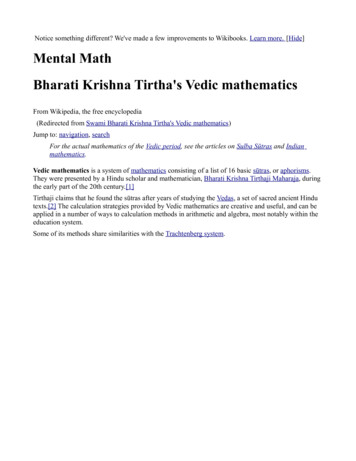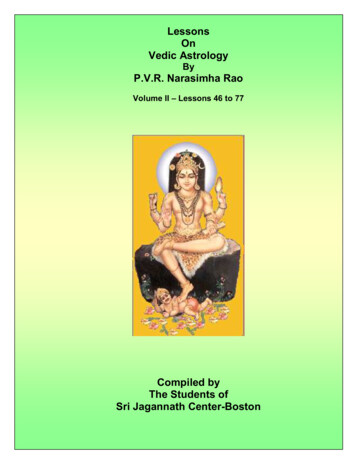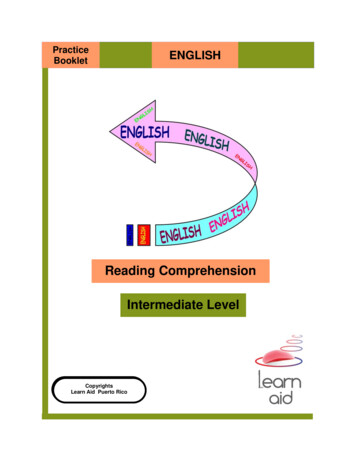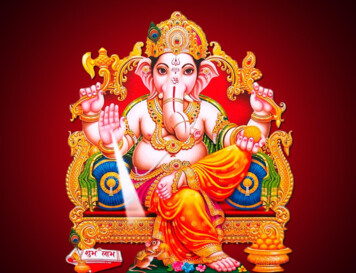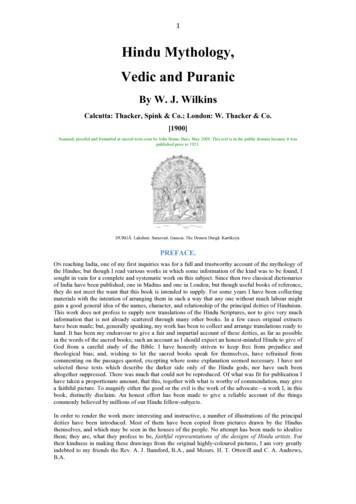
Transcription
1Hindu Mythology,Vedic and PuranicBy W. J. WilkinsCalcutta: Thacker, Spink & Co.; London: W. Thacker & Co.[1900]Scanned, proofed and formatted at sacred-texts.com by John Bruno Hare, May 2009. This text is in the public domain because it waspublished prior to 1923.DURGĀ. Lakshmi. Sarasvati. Ganesa. The Demon Durgā. Kartikeya.PREFACE.ON reaching India, one of my first inquiries was for a full and trustworthy account of the mythology ofthe Hindus; but though I read various works in which some information of the kind was to be found, Isought in vain for a complete and systematic work on this subject. Since then two classical dictionariesof India have been published, one in Madras and one in London; but though useful books of reference,they do not meet the want that this book is intended to supply. For some years I have been collectingmaterials with the intention of arranging them in such a way that any one without much labour mightgain a good general idea of the names, character, and relationship of the principal deities of Hinduism.This work does not profess to supply new translations of the Hindu Scriptures, nor to give very muchinformation that is not already scattered through many other books. In a few cases original extractshave been made; but, generally speaking, my work has been to collect and arrange translations ready tohand. It has been my endeavour to give a fair and impartial account of these deities, as far as possiblein the words of the sacred books; such an account as I should expect an honest-minded Hindu to give ofGod from a careful study of the Bible. I have honestly striven to keep free from prejudice andtheological bias; and, wishing to let the sacred books speak for themselves, have refrained fromcommenting on the passages quoted, excepting where some explanation seemed necessary. I have notselected those texts which describe the darker side only of the Hindu gods, nor have such beenaltogether suppressed. There was much that could not be reproduced. Of what was fit for publication Ihave taken a proportionate amount, that this, together with what is worthy of commendation, may givea faithful picture. To magnify either the good or the evil is the work of the advocate—a work I, in thisbook, distinctly disclaim. An honest effort has been made to give a reliable account of the thingscommonly believed by millions of our Hindu fellow-subjects.In order to render the work more interesting and instructive, a number of illustrations of the principaldeities have been introduced. Most of them have been copied from pictures drawn by the Hindusthemselves, and which may be seen in the houses of the people. No attempt has been made to idealizethem; they are, what they profess to be, faithful representations of the designs of Hindu artists. Fortheir kindness in making these drawings from the original highly-coloured pictures, I am very greatlyindebted to my friends the Rev. A. J. Bamford, B.A., and Messrs. H. T. Ottewill and C. A. Andrews,B.A.
2By the introduction of a full index it is hoped that this work will serve as a classical dictionary of India;whilst the classification of the gods will enable the student to obtain a general view of Hindumythology, and of the relation in which one deity stands to others. And as many legends are given atsome length, the book can hardly fail to be interesting to the general reader, who may not have time oropportunity to refer to the sacred writings from which they are taken.A word of explanation respecting the classification of the deities is called for. It will be noticed thatsome of those described as belonging to the Vedic Age appear under the same or other names in thePurānas; whilst others spoken of as belonging to the Purānic Age have their origin, traceable indeedwith difficulty in some cases, in the Vedas. It was a common practice with the writers of the later booksto claim a remote antiquity, and the authority of the Vedas, for the more recent additions to thePantheon. In some instances an epithet, descriptive of one of the old deities, is attached as the name ofa later one. And by this means the old and the new are linked together. The Vedic gods are those whosedescription is chiefly to be found in the Vedas, and whose worship was more general in the Vedic Age;the Purānic are those who are more fully described in the Purānas, and whose worship was moregeneral in the Purānic Age. Any very rigid classification it is impossible to make.W. J. W.CALCUTTA, February 22, 1882.
3PREFACE TO SECOND EDITION.AS a large edition of this work has been sold out, and a new one called for, an opportunity is presentedof adding a few words to what was said eighteen years ago. The reception given to it both in India andin England was most gratifying, practically the only serious condemnation of it being that I had notpronounced judgment on much that I had quoted from the Hindu sacred books. This was a task that Idistinctly disavowed in my preface. I set out with the intention of rigidly abstaining from comment,commendatory or condemnatory. I feel that a mere statement of much that was written in booksprofessedly inspired by God, carried its own condemnation. And at the same time it was a pleasure toindicate how, amid much evil, there was also much good. The sages of India were not in completedarkness. As we examine the earlier writings, the light was bright indeed contrasted with what camelater. It is most instructive to notice the marked deterioration in the quality of the teaching, deities asdescribed by the earlier sages being vastly better than their successors declare them to be. "NonChristian Bibles are all developments in the wrong direction. They begin with some flashes of truelight, and end in darkness." As Max-Müller says, "The more we go back, the more we examine theearliest germs of any religion, the purer I believe we shall find the conceptions of the Deity."In this edition there is some added matter. Errors have been corrected, and an attempt made to rendercertain passages more clear that were somewhat obscure. Substantially the book remains the same. Anaccount of the ordinary worship and the festivals of these gods will be found in another work—"Modern Hinduism."W. J. W.1900.
4CONTENTS.PART I.—THE VEDIC ETHE VEDASTHE VEDIC GODS GENERALLYDYAUS AND PRITHIVIADITI AND THE ĀDITYASAGNISUN OR LIGHT DEITIES—1. SURYA2. PUSHAN3. MITRA AND VARUNA4. THE ASVINS5. USHASTHE STORM DEITIES—1. INDRA2. INDRĀNI3. PARJANYA4. VĀYU5. THE MARUTSSOMATVASTRI OR RT II.—THE PURĀNIC DEITIES.I.II.III.IV.V.VI.VII.THE PURĀNASBRAHMANBRAHMĀSARASVATIVISHNULAKSHMITHE INCARNATIONS OR AVATĀRAS OF VISHNU—1. THE MATSYA OR FISH AVATĀRA2. THE KŪRMA OR TORTOISE AVATĀRA3. THE VARĀHA OR BOAR AVATĀRA4. THE NRISINGHA OR MAN-LION AVATĀRA5. THE VĀMANA OR DWARF AVATĀRA6. THE PARASURĀMA AVATĀRA7. THE RĀMA CHANDRA AVATĀRA8. THE KRISHNA AVATĀRA8a. THE BALARĀMA AVATĀRA9. THE BUDDHA AVATĀRA10. THE KALKI AUMĀPĀRVATIDURGĀTHE CHIEF FORMS OF DURGĀ—1. DURGĀ2. DASABHUJĀ3. SINGHAVĀHINI4. MAHISHAMĀRDINI5. JAGADDHĀTRI6. 111111112114118118118118118118
VIII.IX.X.57. MUKTAKESI8. TĀRA9. CHINNAMUSTAKA10. JAGADGAURI11. PRATYANGIRĀ12. ANNAPURNĀ13. GANESAJANANI14. KRISHNAKRORATHE SAKTISSONS OF SIVA AND PĀRVATI—1. GANESA2. KARTIKEYATHE PURANIC ACCOUNT OF THE CREATIONTHE PURĀNIC DIVISIONS OF TIME121121121121121121122122122123126129133PART III.—THE INFERIOR DEITIES.II.III.IV.V.VI.VII.VIII.IX.X.I. THE DIVINE RISHIS—1. BHRIGU2. PULASTYA3. PULAHA4. KRATU5. ANGIRAS6. MARICHI7. ATRI8. DAKSHA9. VASISHTHA10. NĀRADAKUVERATHE DEMIGODS OF THE RĀMĀYANA—1. SUGRIVA2. HANUMĀN3. NALA4. NĪLA5. SUSHENATHE DEMIGODS OF THE MAHĀBHĀRATATHE PLANETS—1. RAVI, OR SURYA2. CHANDRA, OR SOMA3. MANGALA4. BUDHA5. VRIHASPATI6. SUKRA7. SANI8. RĀHU AND KETUTHE ASURASJALANDHARASACRED ANIMALS AND BIRDSGARUDAJATĀYUS AND SAMPĀTIGANGĀSACRED TREESMISCELLANEOUS MINOR DEITIES—1. SHITALA2. MANASĀ3. SASTĪ4. THE SHĀLGRĀMA5. THE DHENKĪ6. KA? 178178179179179180
XI.6SUPERHUMAN, THOUGH NOT DIVINE BEINGS—1. APSARAS AND GANDHARVAS2. RĀKSHASAS3. JĀIN DEITIESIndex181182183185This is a comprehensive study of Hindu mythology. Due to the huge number of gods andgoddesses, and their changing role through centuries of Indian spiritual life, this is a complexsubject. This book covers Hindu mythology during the Vedic and Puranic periods. Wilkinsstarts with the very earliest pantheon of the Vedas, such as Surya, the storm-god Maruts,Agni, Soma, Yama, and the dawn Goddess Ushas. From there he moves into the later, andvery intricate, Puranic mythology. This includes detailed treatment of the central triad ofBrahmâ, Vishnu and Shiva, along with dozens of other Gods and Goddesses, nature spirits,half-divine heros of the epics, and so on. Wilkins covers the dozen of so principal avatars ofVishu, including Krishna and (suprisingly) Buddha, and prophecies of the mysterious Kalkiavatar, yet to come. The dozens of line drawings are good reference art for each of the majordeities. If you are attempting a read through of the Rig-Veda, the Mahabharata or Ramayana,this the book will clear up much confusion.--J.B. Hare, May 17th, 2009.
7PART I.THE VEDIC DEITIES.CHAPTER I.BTHE VEDAS.speaking of the Vedic Deities, it is necessary that something be said concerning theVedas themselves, the source of our information concerning them. The root of the word is vid,"to know;" hence the term Veda signifies knowledge; and as these books were not written forcenturies after they were originally composed, it signifies knowledge that was heard, or orallycommunicated. The Vedas are not the work of a single person, but, according to popular belief, werecommunicated to a number of Rishis or saints, who in their turn transmitted them to their disciples. TheSeer Vyāsa is styled the arranger, or, as we should now say, the editor, of these works.EFOREThe instruction contained in these writings is said to have been breathed forth by God Himself. Otherwriters teach that it issued from Him like smoke from fire. Sometimes the Vedas are said to havesprung from the elements. The accounts of their origin, though differing in form, agree in teaching thatthey were the direct gift of God to man; and hence they are regarded with the greatest veneration. Theyare the special property of the Brāhmans. As early as Manu, the nominal author or compiler of a lawbook probably not more than two or three centuries later than the Vedas, though some suppose it tohave been no earlier than A.D. 500, it was regarded as a grave offence for a single word of thesedivinely given books to be heard by a man of a lower caste.The Vedas are four in number; of these the Rig-Veda is the oldest, next in order was the Yajur-Veda,then the Sama-Veda, and last of all the Atharva-Veda. Each of these Vedas consists of two main parts:a Sanhita, or collection of mantras or hymns; and a Brāhmana, containing ritualistic precept andillustration, which stands in somewhat the same relation to the Sanhita as the Talmud to the Law. Inthese are found instructions to the priests who conduct the worship of the gods addressed in. the hymns.Attached to each Brāhmana is an Upanishad, containing secret or mystical doctrine. These are regardedas of lesser authority than the Mantras and Brāhmanas. For whilst they are spoken of as Sruti, i.e.heard, the Upanishads are Smriti, learned. Though based on the older compositions, if there is anydiscrepancy between them, the teaching of the later ones is rejected. The Sanhita and Brāhmana are forthe Brāhmans generally; the Upanishads for philosophical inquirers. Yet, strange to say, whereas theolder portions had, until recent years, been almost entirely neglected, with some parts of theUpanishads there was considerable acquaintance amongst the learned pundits of Benares and otherplaces. In many parts of India not a man could be found able to read and interpret them. Of theSanhitas, the "Rig-Veda Sanhita—containing one thousand and seventeen hymns—is by far the mostimportant; whilst the Atharva-Veda-Sanhita, though generally held to be the most recent, is perhaps themost interesting. Moreover, these are the only two Vedic hymn-books worthy of being called separateoriginal collections;" * the others being almost entirely made up of extracts from the Rig-Veda.Between the time of the composition of the Rig-Veda and that of the Atharva, considerable changes inthe religious faith of the people had come about. The childlike trust of the earlier hymns hasdisappeared, and the deities now seem more cruel, and there is greater need of propitiatory offerings.Probably the old religion of the people whom they had conquered had begun to tell on that of theAryans.The Sanhitas of three of the Vedas are said to have some peculiarity. "If a mantra is metrical, andintended for loud recitation, it is called Rich (from rich, praise) whence the name Rig Veda; i.e. theVeda containing such praises. If it is prose (and then it must be muttered inaudibly), it is called Yajus(yaj, sacrifice, hence, literally, the means by which sacrifice is effected); therefore Yajur-Veda signifiesthe Veda containing such yajus. And if it is metrical, and intended for chanting, it is called Sāman[equal]; hence Sāman Veda means the Veda containing such Samans. The author of the Mantra, or asthe Hindus would say, the inspired 'Seer,' who received it from the Deity, is termed its Rishi; and theobject with which it is concerned is its devata—a word which generally means a 'deity,' but themeaning of which, in its reference to mantras, must not always be taken literally, as there are hymns inwhich not gods nor deified beings, but, for instance, a sacrificial post, weapons, etc., invoked, are
8considered as the devata.1 It should, however, be noticed that the deifying of a "sacrificial post" or a"weapon" is in perfect harmony with the general pantheistic notions which prevailed amongst thepeople then as now: so that there is nothing unnatural according to their religious ideas in speakingeven of inanimate objects as deities. There is little doubt that the Brāhmanas are more recent than theSanhitas.The Vedas have not come down to the present time without considerable dispute as to the text. Asmight have been expected, seeing that this teaching was given orally, discrepancies arose. One accountmentions no less than twenty-one versions (Sākhās) of the Rig-Veda; another gives five of the RigVeda, forty-two of the Yajur-Veda, mentions twelve out of a thousand of the Sāman-Veda, and twelveof the Atharva-Veda. And as each school believed that it possessed the true Veda, it anathematizedthose who taught and followed any other. The Rig-Veda Sanhita that has survived to the present age isthat of one school only, the Sākala; the Yajur-Veda is that of three schools; the Sāma-Veda is that ofperhaps two, and the Atharva-Veda of one only."The history of the Yajur-Veda differs in so far from that of the other Vedas, as it is marked by adissension between its own schools far more important than the differences which separated the schoolof each [of the] other Vedas. It is known by the distinction between a Yajur-Veda called the Black—and another called the White—Yajur-Veda. Tradition, especially that of the Purānas, records a legendto account for it. Vaisampāyana, it says, a disciple of Vyāsa, who had received from him the YajurVeda, having committed an offence, desired his disciples to assist him in the performance of someexpiatory act. One of these, however, Yājnavalkya, proposed that he should alone perform the wholerite; upon which Vaisampāyana, enraged at what he considered to be the arrogance of his disciple,uttered a curse on him, the effect of which was that Yājnavalkya disgorged all the Yajus texts he hadlearned from Vaisampāyana. The other disciples, having been meanwhile transformed into partridges(tittiri), picked up these tainted texts and retained them. Hence these texts are called Taittiriyas. ButYājnavalkya, desirous of obtaining Yajus texts, devoutly prayed to the Sun, and had granted to him hiswish—'to possess such texts as were not known to his teacher.'"2 And thus there are two Yajur-Vedasto this day; the Black being considered the older of the two.As to the date of the Vedas, there is nothing certainly known. There is no doubt that they are amongstthe oldest literary productions of the world. But when they were composed is largely a matter ofconjecture. Colebrooke seems to show from a Vaidick Calendar that they must have been writtenbefore the 14th century B.C. Some assign to them a more recent, some a more ancient, date. Dr. Haugconsiders the Vedic age to have extended from B.C. 2000 to B.C. 1200, though he thinks some of theoldest hymns may have been composed . B.C. 2400. Max-Müller gives us the probable date of theMantra, or hymn portion of the Vedas, from B.C. 1200 to B.C. 800, and the Brāhmanas from B.C. 800to B.C. 600, and the rest from B.C. 600 to B.C. 200.There is nothing whatever in the books themselves to indicate when they were written. All referencesin them are to their being given orally, learned, and then again taught audibly to others. Probably forcenturies after the art of writing was known in India it was not employed for preserving the sacredbooks, as in the Mahābhārata those who write the Vedas are threatened with the punishment of hell.(9)1"Indian Wisdom," p. 9.2Goldstücker, art. "Vedas," Chambers's Cyclopædia.
9CHAPTER II.THE VEDIC GODS GENERALLY.Y(probably the oldest commentator on the Vedas) gives the following classification of theVedic gods. "There are three deities, according to the expounders of the Vedas: Agni, whoseplace is on the earth; Vāyu or Indra, whose place is in the air; and Surya, whose place is in thesky. These deities receive severally many appellations in consequence of their greatness, or of thediversity of their functions."3 In the Rig-Veda itself this number is increased to thirty-three, of whomeleven are said to be in heaven, eleven on earth, and eleven in mid-air. "Agni, the wise god, lends anear to his worshippers. God with the ruddy steeds, who lovest praise, bring hither those three-andthirty." This is the number usually mentioned, though it is by no means easy to decide which are thethirty-three intended, as the lists found in various places vary considerably; whilst in another verse it issaid that "three hundred, three thousand, thirty-and-nine gods have worshipped Agni."ASKAThese deities, though spoken of as immortal, are not said to be self-existent beings; in fact theirparentage in most cases is given; but the various accounts of their origin do not agree with each other.Agni and Savitri are said to have conferred immortality upon the other gods; whilst it is also taught thatIndra obtained this boon by sacrifice. An interesting account is given in the Satapatha Brāhmana * ofthe means by which the gods obtained immortality, and superiority over the asuras or demons. All ofthem, gods and demons alike, were mortal, all were equal in power, all were sons of Prajāpati theCreator. Wishing to be immortal, the gods offered sacrifices liberally, and practised the severestpenance; but not until Prajāpati had taught them to offer a particular sacrifice could they becomeimmortal. They followed his advice, and succeeded. Wishing to become greater than the asuras, theybecame truthful. Previously they and the asuras spoke truthfully or falsely, as they thought fit; butgradually, whilst they ceased from lying, the asuras became increasingly false; the result was that thegods after protracted struggles gained the victory. Originally the gods were all equal in power, all alikegood. But three of them desired to be superior to the rest, viz. Agni, Indra, and Surya. They continuedto offer sacrifices for this purpose until it was accomplished. Originally there was not in Agni the sameflame as there is now. He desired, "May this flame be in me," and, offering a sacrifice for theattainment of this blessing, obtained it. In a similar manner Indra increased his energy, and Surya hisbrightness. These three deities form what is commonly described as the Vedic Triad. In later timesother three took their place, though an attempt is made to show them to be the same.It will be noticed that each of the gods is in turn regarded by the worshipper as superior to all theothers. In the Vedas this superlative language is constantly employed, and identical epithets areindiscriminately given to various deities. Professor Max-Müller says, "When these individual gods areinvoked, they are not conceived as limited by the power of others, as superior or inferior in rank. Eachgod, to the mind of the supplicants, is as good as all the gods. He is felt at the time as a real divinity, assupreme and absolute, in spite of the limitations which, to our mind, a plurality of gods must entail onevery single god. All the rest disappear for a moment from the vision of the poet, and he only who is tofulfil their desires, stands in full light before the eyes of the worshippers. . . . It would be easy to find,in the numerous hymns of the Rig-Veda, passages in which almost every single god is represented assupreme and absolute."The will of these gods is sovereign; no mortal can thwart their designs. They exercise authority over allcreatures. In their hands is the life of mortals. They know the thoughts and intentions of men, andwhilst they reward the worshipper, they punish those who neglect them.When the Puranic deities are described it will be noticed that the representations of the deities of thatage are far more clearly defined than those of earlier times. Though the Vedic gods are spoken of aspossessing human forms and acting as human beings, there is considerable vagueness in the outline.But as time goes on this is lost. The objects of worship are no longer indistinct and shadowy, but are sominutely described that their portraits could be easily painted. And as their physical features are nolonger left to the imagination, so their mental and moral characters are fully delineated. They are of likepassions with those who depict them, only possessing vastly greater powers.3Muir, O. S. T., v. 8.
10Professor Williams says4 "that the deified forces addressed in the Vedic hymns were probably notrepresented by images or idols in the Vedic period, though doubtless the early worshippers clothedtheir gods with human forms in their own imaginations." Professor Müller5 speaks more positively:"The religion of the Veda knows of no idols. The worship of idols in India is a secondary formation, alater degradation of the more primitive worship of ideal gods." The guarded language of ProfessorWilliams seems to be better suited to the facts, as far as they are known, for Dr. Bollensen6 speaksquite as strongly on the other side. He writes, "From the common appellation of the gods as divo naras,'men of the sky,' or simply naras, 'men,' and from the epithet nripesas, 'having the form of men,' wemay conclude that the Indians did not merely in imagination assign human forms to their gods, but alsorepresented them in a sensible manner. Thus a painted image of Rudra (Rig-Veda, ii. 33, 9) is describedwith strong limbs, many-formed, awful, brown, he is painted with shining colours.'" "Still clearerappears the reference to representations in the form of an image. 'I now pray to the gods of these(Maruts).' Here it seems that the Maruts are distinguished from their gods, i.e. their images.'" "There isin the oldest language a word, 'Sandris,' which properly denotes 'an image of the gods.'We shall now proceed to the consideration in detail of the deities as described in the Vedas.4Muir O. S. T., iv. 54-62.5"Indian Wisdom," p. 15.6Muir, C. S. T., v. 453
11CHAPTER III.TDYAUS AND PRITHIVI.general opinion respecting Dyaus (Heaven) and Prithivi (Earth) is that they are amongst themost ancient of the Aryan deities, hence they are spoken of in the hymns of the Rig-Veda as theparents of the other gods.7 They are described as "great, wise and energetic;" those who"promote righteousness, and lavish gifts upon their worshippers." And in another place they are said tohave "made all creatures," and through their favour "immortality is conferred upon their offspring." Notonly are they the creators, but also the preservers of all creatures; and are beneficent and kind to all. Inother passages Heaven and Earth are said to have been formed by Indra, who is declared to transcendthem in greatness, whom they follow "as a chariot follows the horse." They are described as bowingdown before him; as trembling with fear on account of him; and as being subject to his control. Again,they are said to have been formed by Soma; and in other verses other deities are said to have madethem. This confusion of thought respecting the origin of the gods led very naturally to the questionbeing asked in other hymns, "How have they been produced? Who of the sages knows?"HEThere seems to be considerable ground for the opinion that Indra gradually superseded Dyaus in theworship of the Hindus soon after their settlement in India. As the praises of the newer god were sung,the older one was forgotten; and in the present day, whilst Dyaus is almost unknown, Indra is stillworshipped, though in the Vedas both are called the god of heaven. The following statement ofProfessor Benfey8 gives a natural explanation of this. "It may be distinctly shown that Indra took theplace of the god of heaven, who, in the Vedas, is invoked in the vocative as Dyauspitar (Heavenfather). This is proved by the fact that this phrase is exactly reflected in the Latin Jupiter, and the GreekZeū-pater as a religious formula, fixed, like many others, before the separation of the languages. Whenthe Sanskrit people left the common country, where for them, as well as for other kindred tribes, thebrilliant radiance of heaven appeared to them, in consequence of the climate there prevailing, as theholiest thing, and settled in sultry India, where the glow of the heavens is destructive, and only its rainoperates beneficially, this aspect of the Deity must have appeared the most adorable, so that the epithetPluvius, in a certain sense, absorbed all the other characteristics of Dyauspitar. This found itsexpression in the name In-dra, in which we unhesitatingly recognize a word (which arose in some localdialect, and was then diffused with the spread of the worship) standing for Sind-ra, which again wasderived from Syand, 'to drop.' The conceptions which had been attached to Dyaus were then transferredto Indra." The opinion that Indra has taken the place of Dyaus is now pretty generally believed, and theabove explanation appears natural.Of Prithivi we hear again. The "Vishnu Purāna"9 gives the following account of her birth. There was aking named Venā, notorious for his wickedness and general neglect of religious duties. When theRishis of that age could bear with his impiety no longer, they slew him. But now a worse evilhappened; anarchy prevailed, and they felt that a bad king was better than none at all. Upon this theyrubbed the thigh of Venā, when there came forth a black dwarf, resembling a negro in appearance.Immediately after his birth the dwarf asked, "What am I to do?" He is told, "Nisīda" (sit down), andfrom this his descendants are called "Nisidis" unto this day. The corpse was now pure, as all sin hadleft it in the body of this black dwarf. The right arm was then rubbed, and from it there came a beautifulshining prince, who was named Prithu, and reigned in the place of his father. Now during his reignthere was a terrible famine. As the Earth would not yield her fruits, great distress prevailed. Prithu said,"I will slay the Earth, and make her yield her fruits." Terrified at this threat, the Earth assumed the formof a cow, and was pursued by Prithu, even to the heaven of Brahmā. At length, weary with the chase,she turned to him and said, "Know you not the sin of killing a female, that you thus try to slay me?"The king replied that "when the happiness of many is secured by the destruction of one malignantbeing, the slaughter of that being is an act of virtue." "But," said the Earth, "if, in order to promote thewelfare of your subjects, you put an end to me, whence, best of monarchs, will thy people derive theirsupport?" Overcome at length, the Earth declared that all vegetable products were old, and destroyedby her, but that at the king's command she would restore them "as developed from her milk." "Do you,therefore, for the benefit of mankind, give me that calf by which I may be able to secrete milk. Make7Muir, O. S. T., v. 23.8Muir, O. S. T., v. 18.9"Vishnu Purāna," p. 104.
12also all places level, so that I may cause my milk, the seed of all vegetation, to flow everywherearound."Prithu acted upon this advice. "Before his time there was no cultivation, no pasture, no agriculture, nohighways for merchants; all these things (or all civilization) originated in the reign of Prithu. Where theground was made level, the king induced his subjects to take up their abode. . . . He therefore havingmade Swayambhuva Manu the calf, milked the Earth, and received the milk into his own hand, for thebenefit of mankind. Thence proceeded all kinds of corn and vegetables upon which people now subsist.By granting life to the Earth, Prithu was as her father, and she thence derived the patronymicappellation Prithivi."In a note Professor Wilson adds,10 the commentator observes that "by the 'calf,' or Manu in thatcharacter, is typified the promoter of the multiplication of progeny;" Manu, as will be seen in theaccount of the Creation, being regarded by some of the Purānas as the first parent of mankind. Th
! 5! 7. muktakesi 121 8. tĀra 121 9. chinnamustaka 121 10. jagadgauri 121 11. pratyangirĀ 121 12. annapurnĀ 121 13. ganesajanani 122 14. krishnakrora 122 the saktis 122 viii. sons of siva and pĀrvati— 1. ganesa 123 2. kartikeya 126 ix. the puranic account of the creation 129 x. the purĀnic divisions of time
